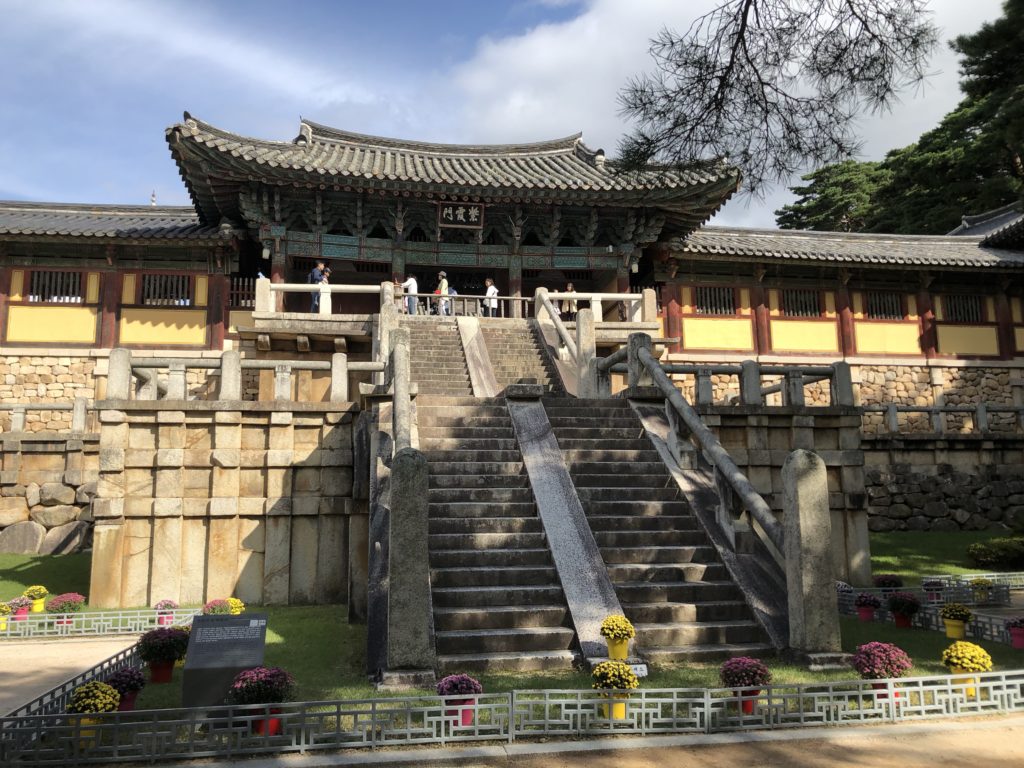South Korea is full of cultural heritage sites, and is the home of many UNESCO sites. These world heritage sites are places of importance to. Cultural or. Natural heritage as defined by the UNESCO World Heritage Convention. In total South Korea has 14 world heritage sites, 13 of them have cultural importance and 1 has natural importance. Lets check out the top ten of these sites.
Bulguksa Temple & Seokguram Grotto

Located near Gyeongju, these two sites are steeped in Buddhist history, they are worth the visit. Originally built in 774 during the Silla dynasty, it has been expanded and rebuilt over time. They are near each other however it requires a 1 hour hike or 20minute drive to get between them. However there is a bus that runs between the two sites if you don’t want to drive or hike between them. Check out the timetable below to help plan your trip, which I’ve also translated into English.

Bulguksa Temple and Seokguram Grotto bus timetable – Korean. 
Bulguksa Temple and Seokguram Grotto bus timetable – English.
| Bus | Bulguksa Temple | Seokguram Grotto |
| 1 | 8:40 | 9:00 |
| 2 | 9:40 | 10:00 |
| 3 | 10:40 | 11:00 |
| 4 | 11:40 | 12:00 |
| 5 | 12:50 | 13:05 |
| 6 | 13:40 | 14:00 |
| 7 | 14:40 | 15:00 |
| 8 | 15:40 | 16:00 |
| 9 | 16:40 | 17:00 |
| 10 | 17:20 | 18:20 |
Baekje Historic Areas
The Baekje historic areas can found near the modern day city of Buyeo that used to be the seat of the Baekje kingdom. The sites include Gongsanseong fortress, Royal tombs, administrative bindings and much more. Buyeo is only around 2 hours from Seoul making it very accessible for all those interested in the history of the Baekje kingdom.
Jongmyo Shrine
Situated in the Jongno region of Seoul, Jongmyo was of great importance during the Joseon dynasty housing the spirits of all past kings. It served as a location for storing steles (and spirits) as well as a place to perform ancestral rites. It is a beautiful forested area in the middle of a concrete jungle. Many animals enjoy roaming in the forest surrounding the buildings in Jongmyo.
Changdeokgung
Changdeokgung is one of the 5 main royal palaces in Seoul, and the only one to be named a UNESCO world heritage site. This is due to it being and outstanding example of Far Eastern palace architecture and garden design. A lot of the palace has been burned down during Japanese occupation but most has been rebuilt and restoration is ongoing. The palace grounds also contains a secret garden used by the kings for relaxation and a place to work in peace.
Namhansanseong
This fortress can be found south east of Seoul, protected by the surrounding mountains. It was designed as a location for an emergency palace, and has been greatly expanded and developed over the years to deal with advances in military technology. You can hike around the whole wall of the fortress to get great views of all sides or you can visit the emergency palace which is open to the public. If you visit the information. Center you might be able to snag a nice Namhansanseong badge as a souvenir.

Jeju Island
Jeju Island is named as the only natural world heritage site in South Korea. This is due to the volcanic nature of the island which is how it was formed. In particular there are many fascinating geological formations all over the island. This includes many lava tubes, the Seongnam Ilchulbong tuff cone and Hallasan, the tallest mountain in South Korea. Jeju is a amazing place to visit for these sites, as well as having terrific food and beaches.
Yangdong Village
Yangdong is one of the two world heritage recognized historic Joseon folk villages. It is still inhabited by people however most of them are older and fewer residents are staying over time. They are both fantastic examples of a Confucian layout of a villages, sheltered by forested mountains and facing out to rivers and fields for farming.
Hwaseong
Hwaseong fortress is another UNESCO recognized fortress built during the Joseon dynasty. It has been preserved incredibly well and you can walk around the most of the fortress wall. It was originally built by Joseon King Jeongjo to house his father’s tomb and every year he would visit precipitating a festival which continues to this day.

Royal Joseon Tombs
There are many royal tombs from the Joseon dynasty with most of them in the Seoul region. Seoulleung is in the middle of the city and is the easiest to visit when traveling to Seoul. Like Jongmyo it is a fantastic green space in the midst of a concrete jungle. There are three tombs in total, and it is a peaceful walk through the forest as you visit each one.
Gyeongju historic areas

Gyeongju, known as the museum without walls, due to the amount of culturally significant sites located throughout the city. The royal tombs of Silla are perhaps the most well known. They are large earth mounds dotted around the city containing tombs for kings and other high ranking officials. It also includes many Buddhist pagodas throughout the city and the ruined palace of Wolseong and Anapji pond which has only been minimally restored.
So there we have some fantastic cultural sites to visit in South Korea. Have you been to any of these UNESCO world heritage locations? Which one do you think is the best to visit? Send us a comment below with you opinion!

Alche is a passionate writer about many topics and wants to share knowledge in a simple way so all readers can enjoy and learn.
